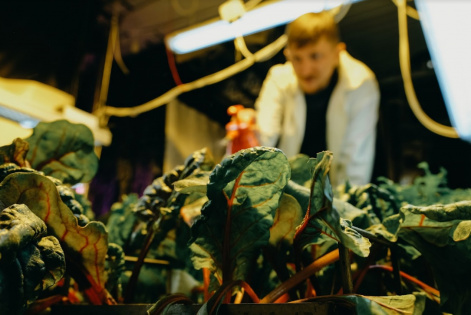Lunar base station should be based on a closed life support system of a new type
12 April 2021 г.

Krasnoyarsk biophysicists have presented BIOS-4. This is a closed life support system of a new type, which is to become the main future lunar base station. On April 8, at the general meeting of the Siberian Branch of RAS, Academician of the Russian Academy of Sciences Andrei Georgievich Degermendzhi presented the developments of scientists of the Federal Research Center "Krasnoyarsk Science Center of SB RAS", which makes it possible to completely close the cycle and provide future space colonists with food, air and clean water. The task of developing an experimental closed life support system was set to Krasnoyarsk scientists by Sergei Korolev himself back in the 60s of the last century. As early as in the 1970s, "BIOS-3" was created in Krasnoyarsk, which is a sealed bunker with four equal-sized compartments: a living module and three modules with plants and algae. The longest and most famous experiment involving humans lasted 180 days, from December 24, 1972 to June 22, 1973. Three researchers breathed oxygen released by plants growing in BIOS-3, the water being purified inside the system. Thus, a complete closure of the system for oxygen and carbon dioxide was achieved and almost so (95%) for water. All the plant food, 50-70% of human diet, consisted of wheat and vegetables grown in BIOS. However, BIOS-3 was not completely closed. There were substances in the system which did not return to the circulation, and, therefore, were accumulated in the form of "dead ends". Such compounds, in particular, included human solid excreta, dissolved salts, inedible parts of plants. Due to this, the balance was disturbed and the closing coefficient reduced. At the scientific session of the general meeting of SB RAS, dedicated to the 60th anniversary of Yuri Gagarin's flight into space, Academician of the Russian Academy of Sciences, Director of the Institute of Biophysics of SB RAS Andrei Degermendzhi told about the achievements of Krasnoyarsk scientists which allow creating a new type of the life support system with an almost completely closed system concerning all the components. At present, in Krasnoyarsk unique facilities have been created for processing all types of organic waste and its involvement into a closed cycle. A technology has been developed for deep purification of gases emitted during the processing of organic matter, such as ammonia and volatile organic compounds. The problem of salt has been solved, which previously could not be completely extracted from human organic waste and returned to the circulation. Technologies for creating a soil-like substrate and for introducing a protein component into the system have been developed. “It remains to combine all the available technologies into one system and make BIOS-4. Just a few days ago, a memorandum on the creation of a scientific lunar station was signed between the state corporation Roscosmos and the Chinese National Space Agency. So it is necessary to start working right now. We can't hesitate, because only basic experiments will take 3-4 years. We need “a new Korolev”, a leader who will pave the way for the work of planetary significance, ” concludes Andrei Degermendzhi. The general meeting of SB RAS decided to propose Roscosmos to hold a joint meeting in the near future, which will consider a number of breakthrough projects of Siberian space scientists, including the closed life support system. It should be noted that such technologies are also applied here, on the ground. The elements of the life support system can be used to create eco-houses in the Arctic to get rid of organic waste, receive fertilizers and create greenhouse complexes for growing fresh vegetables and herbs. Closed ecosystems can also be useful for ecological research, for example, testing the effects of global warming on plants, permafrost or aquatic ecosystems.
________________________________________
Also recently, before the Cosmonautics Day, Krasnoyarsk scientists told the Yenisei TV channel about the latest developments in the field of closed human life support systems. Watch the full release of the Alexander Prudnikov’s program "What and How".
Share:
